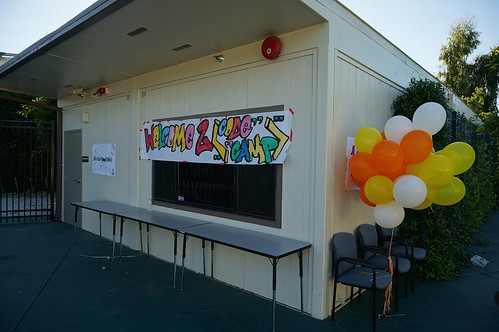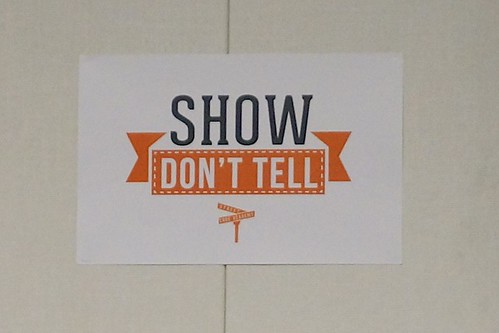Last Friday, 8 August 2014, I had the fortune to be able to attend the demo night of CodeCamp in East Palo Alto (EPA).

The power of coding
CodeCamp is an initiative by enthusiastic coders, primarily university students, to help high school students in East Palo Alto to see what they can achieve with coding during the summer and opening their eyes to possibilities for their futures.
At the end of the 4-week summer programme, a demo night was organized where this year’s students (the website doesn’t have video or their photos up yet) pitched their ideas and showed off what they had created.
But before the students had their say, there was a short keynote address by 2 co-founders of a start-up (of which I forgot the name 🙁 ). They said that besides the obvious coding skills, coding can teach the following:
- Power of focus
- Think for yourself
- How to build great relationships because coding is a team sport
All these three qualities were demonstrated by the students during their project pitches. We listened to pitches from 6 student groups that all had different project ideas for which they had created a website.
The projects
AfroGan is a group of 3 young women who created a site to showcase their cultural heritage and provide information about African American and Tongan culture, food, traditions etc. They created the site because they didn’t know much about their own cultures and wanted to explore them further. They invite others to participate and provide information, photos etc. to enrich the site.
The Pointeers are a group of 4 young women who wanted to give non-profits in EPA a voice and encourage young people to go to events. They would not only provide a platform where non-profits can announce their events, but also where they create activities / missions / challenges for young people to complete when they go to these events thus making it more fun for students to participate.
Vicious and delicious are a group of 3 young men who created a site where you can scan your shopping receipts so that you can look them up easily when you misplaced them or thrown them away. The site would also allow you to geotag them to be reminded more easily where you bought stuff.
Positive Vibes was created for teenagers to come to for help when they experienced abuse, bullying etc. The 3 teenagers who created the site have seen their fair share of abuse and sadness in their community, and they want to make a difference. Their site does not only offer written advice, but would also have counsellors available that could talk to the kids who seek support and help them as best as possible.
Nemesis Gaimz is a collaboration of 3 young men who created a game that you can easily play on any computer and for which you wouldn’t need fancy equipment. They created all the graphics themselves. The best thing about their game was the language used for when you you got hit by an obstacle and you lost that level. They didn’t like the “You are dead” language as it’s negative. So they came up with “You are deaded”.
And last not least, SuaveFX, a collaboration of 3 young men who set up a site to showcase local talent. They want to get the word out about their local stars and give them a platform to present themselves.
All 6 projects were well thought out and showed a lot of maturity amongst the students for finding their topics. They were predominantly community-focused, and you could tell that they thought about their projects a lot to come up with something that was worthwhile pursuing. Part of their project presentations was also to pitch their projects to the audience as they would need funding to continue their efforts and put their sites and services up online. We did not get to vote for our favorite project (maybe something to do at next year’s CodeCamp), but could ask the students questions about their project progress, what they learned and where they wanted to go from here.
Outcomes of CodeCamp
The aims of CodeCamp were not only to teach them coding skills, but also soft skills and empower them in finding who they are. Yes, the students learned HTML, CSS and Javascript, and they worked with Foundation and Bootstrap once they had gained knowledge of how to set up a website from scratch. But they learned so much more.
I had the opportunity to speak with Shadi Barhoumi, one of the main organizers of CodeCamp, and it became clear to me that community empowerment and community building was important to him for the CodeCamp and teaching the kids. They did not only code, but they also played games and music together, went on excursions and came together as a group.
A number of the kids said during their final remarks that they have a new family in all the participants of CodeCamp. They grew very close to each other and appreciate each other much for who they are. The road was not always easy, but with the help of their mentors, they pulled through, finished the program, and now have something to show off. Some also said they got skills that will take them far, and they now have the confidence to apply for an internship or even look into studying programming at college / university. They now have a better outlook on things and see themselves a part of the tech industry that surrounds them, and will take further steps in them.
One student said: We are seeing how we want to be: loving, amazing and skillful.
I was interested in attending the demo night because we run an annual Open Source Academy in Wellington for high school students. Thus, I wanted to see what other programs do, and what we can learn from them. I learned a lot from CodeCamp just by having been at the demo night.
Shadi and the other mentors accomplished a lot with the students giving them a new outlook on their future by opening up a career path for a number of them who had not considered computer science as a career. They also helped the kids by coming together in a very tight knit community and making them see that it’s not just about the work you do, but also with whom you do it and that you need others on your team. Demo night was attended by parents and friends of the students as well as other community members who are involved in community activities in EPA, and then a few others like me who have more or less loose connections with the program.
I enjoyed watching the kids interact and move effortlessly between their work – presenting their pitches – and play and talking with members of the community about CodeCamp. Not just making it about the coding, but also having a good deal of time available for the students to just play is great. Having been located at a school where they can go outside and play ball or run around has its advantages. We’d be very limited in our multi-story building in the city center for such activities.
One thing Shadi mentioned that helped the students get into the mood for the summer of coding and for sticking with it, was the hackathon that was organized at the beginning of the program. The hackathon was so very intense and energizing that it was the perfect start to capture the students’ attention and make them want to continue. And by judging the enthusiasm that the students exhibited at the end of the program, it worked out very well.
The things that I took away from the demo night were that immense sense of community amongst the people there from EPA, the enthusiasm that the students showed throughout the event and also their insight into what their community needs, and the great opportunity for the students to demo their project results not only to their fellow campers, but to the wider community.
So, if you are looking for a talented student with knowledge in HTML, CSS and JS, watch out for the CodeCamp students.

![]() This work is licensed under a Creative Commons Attribution-ShareAlike 4.0 International License.
This work is licensed under a Creative Commons Attribution-ShareAlike 4.0 International License.